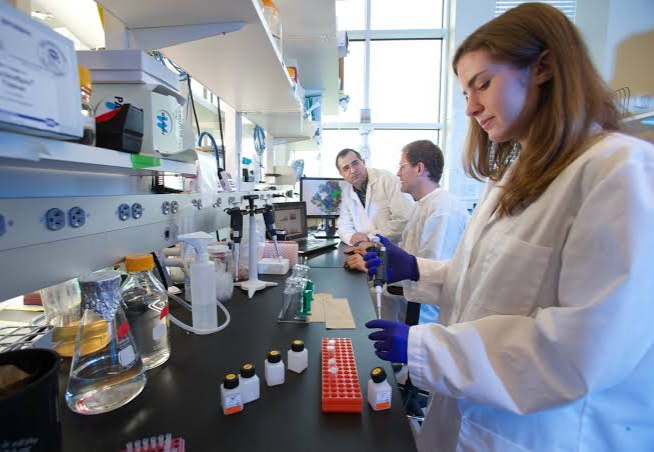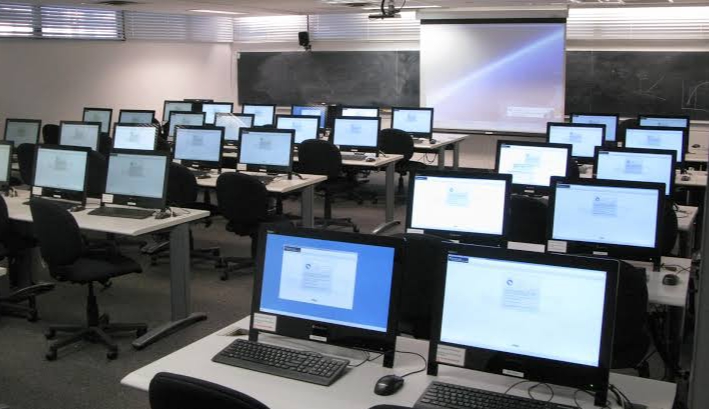Wet Lab (Liquid/Water Based Experiment Lab)
Wet labs also referred to as liquid based laboratories are laboratories where different type of components are tested and analyzed using liquid. These types of labs handle a range of biological specimens, chemicals, drugs and other types of matter for use in experiments.
Some of the tools, equipments and services in wet lab, include:
- Lab bench countertops and sinks which can be cleaned easily and are resistant to bacteria and chemicals.
- Vibration controls for sensitive experiments such as DNA sequencing.
- Piped in compressed air and vacuum as well as gases such as oxygen
- Specialized refrigerators and freezers for storing tissue and other specimen.
- Controlled environment areas (warm or cold rooms)
- Autoclaves and other sterilization equipments.
- Drain, waste and vent services.

Examples Of Wet Labs
Biomedical Laboratories
- Anaerobic Chamber Labs
- Cell Biology Labs
- Fermenter Labs
- Molecular Biology Labs
- Pathology Labs
- Tissue Culture Labs
Chemistry Laboratories
- Organic Chemistry Labs
- Physical Chemistry Labs
What You Need To Know About Wet Lab
- Wet labs also referred to as liquid based laboratories are laboratories where chemicals, drugs or other biological matter are tested and analyzed using liquid.
- In wet laboratories, liquids are primarily used in analysis.
- Diffraction of light in physics, titration in chemistry and enzyme characterization in biology are example of experiments that are carried out in a wet laboratory.
- Wet laboratories are specially designed with material and furnishes that are resistant to bacteria and chemicals.
- Wet laboratories are in many cases designed with Biosefty cabinets, specialized refrigerators and freezers.
- In wet laboratories, there are different equipments and facilities with varied functions.
- Due to nature of experiments which majorly entail the handling of liquids, wet laboratories require benches, sinks, hoods safety equipments, direct ventilation and piping as a major consideration.
- Nearly all experiments that are carried out in a wet laboratory have well known procedures and follow a certain pattern.
Dry Lab (Computer Assisted Lab)
Dry laboratories also referred to as computer assisted labs are laboratories where analysis of data is conducted with computers and mathematical analysis. In dry labs, computers are used to carry out analysis, modeling and simulation.
Some of the tools, equipments and services in dry lab, include:
- Fire control system
- Vibration controls for sensitive instruments that need to maintain calibration.
- Occasional clean room system installations are required for certain processes and experiments.
- Clean power systems for sensitive computers, instruments and network communications.
- Extensive cooling and humidity controls (HVAC).
Examples of Dry Labs:
- Computer Labs (Mainframe, Workstation and PCs)
- Confocal Microscope Labs
- X-Ray Crystallography Labs
- Laser Labs
- Mass Spectrophotometry (MS) Labs
- Flow Cytometry
- Electrophysiology and Biophysics Labs
- Electron Microscope (EM) Labs
- Electromagnetic Instrument Labs

What You Need To Know About Dry Lab
- Dry laboratories also referred to as computer assisted labs are laboratories where computational or applied mathematical analyses are done with assistance of computer generated models.
- In dry laboratories, electronic equipments such as computers are used in analyzing and evaluation of data.
- Quantum state analysis, mapping or networking, ground theory methodology, coding and text interpretation are examples of computer assisted experiments.
- Dry laboratories are specially designed with clean power systems for sensitive computers, research instruments for sensitive computers, research instruments and network communication.
- Dry laboratories are in many cases designed with HVAC controls to support cooling and humidity levels.
- In dry laboratories, it only the computers that are used to carry out analysis, modeling and simulations.
- The nature of work in a dry laboratory primarily entails manipulation and analysis of data on a computer network, an effective integrated communication system is usually a major consideration.
- Almost all dry laboratory experiments occur inside the online mode while other occurs in an offline mode.
Difference Between Wet Lab And Dry Lab In Tabular Form
| BASIS OF COMPARISON
| WET LAB | DRY LAB |
| Description | Wet labs also referred to as liquid based laboratories are laboratories where chemicals, drugs or other biological matter are tested and analyzed using liquid. | Dry laboratories also referred to as computer assisted labs are laboratories where computational or applied mathematical analyses are done with assistance of computer generated models. |
| Analysis | Liquids are primarily used in analysis. | Electronic equipments such as computers are used in analyzing and evaluation of data. |
| Experiments | Diffraction of light in physics, titration in chemistry and enzyme characterization in biology are example of experiments that are carried out in a wet laboratory. | Quantum state analysis, mapping or networking, ground theory methodology, coding and text interpretation are examples of computer assisted experiments. |
| Design | Wet laboratories are specially designed with material and furnishes that are resistant to bacteria and chemicals. | Dry laboratories are specially designed with clean power systems for sensitive computers, research instruments for sensitive computers, research instruments and network communication. |
| Main Equipments | There are different equipments and facilities with varied functions. | It is only the computers that are used to carry out analysis, modeling and simulations. |
| Lab’s Major Consideration | Due to nature of experiments which majorly entail the handling of liquids, wet laboratories require benches, sinks, hoods safety equipments, direct ventilation and piping as a major consideration. | The nature of work in a dry laboratory primarily entails manipulation and analysis of data on a computer network, an effective integrated communication system is usually a major consideration. |
| Mode of Experiments | Nearly all experiments that are carried out in a wet laboratory have well known procedures and follow a certain pattern. | Almost all dry laboratory experiments occur inside the online mode while other occurs in an offline mode. |